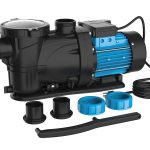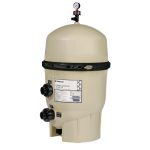You should replace the sand in your pool filter every 7-10 years for optimal performance and filtration. A well-maintained pool filter is crucial for keeping your swimming pool clean and safe.
One important aspect of pool filter maintenance is the periodic replacement of the filter media, which is typically sand. Over time, the sand in your pool filter can become worn down and lose its effectiveness in trapping dirt and debris. This can lead to reduced filtration efficiency and poorer water quality.
To ensure your pool filter is working at its best, it is recommended to replace the sand every 7-10 years. By doing so, you can maintain a crystal-clear pool and extend the lifespan of your pool equipment. Regularly replacing the sand in your pool filter is a simple yet essential step in pool maintenance that shouldn’t be overlooked.
1. Importance Of The Pool Filter Sand
Proper filtration is essential for maintaining clean and clear water in your pool. The pool filter sand plays a crucial role in this process. It functions by trapping and removing impurities from the water as it passes through the filter.
Over time, the sand becomes saturated with debris and may lose its effectiveness. Therefore, it is important to replace the sand periodically to ensure optimal filtration. While there is no one-size-fits-all answer to how often you should replace the sand, a general guideline is every 3-5 years.
However, factors such as the size of your pool, frequency of use, and water quality should also be considered. Regular maintenance and monitoring of the filter’s performance can help determine when it’s time for a sand replacement. By following these guidelines, you can ensure that your pool filter continues to provide clean and clear water for your swimming enjoyment.
2. Signs That The Sand Needs Replacement
Replacing the sand in your pool filter is necessary to maintain its efficiency. One sign that the sand needs replacement is a loss of filtration efficiency. When the sand is no longer able to filter out impurities effectively, it’s time for a change.
Another indication is increased pressure on the filter system. If you notice that the pressure gauge consistently reads higher than usual, it’s a clear signal that the sand needs to be replaced. Additionally, poor water clarity can also indicate the need for sand replacement.
If your pool water appears cloudy or dirty even after proper filtration, it’s likely due to worn-out sand. Regularly inspect these signs to ensure optimal performance from your pool filter.
3. Frequency Of Sand Replacement
The frequency of sand replacement in a pool filter can vary depending on several factors. Expert recommendations for sand replacement typically suggest doing it every 3 to 5 years. However, certain factors can influence this timeframe. Factors like the size of the pool, usage frequency, water quality, and environmental factors such as debris and contaminants can impact the lifespan of the sand in the filter.
For instance, a larger pool or heavy pool usage may require more frequent sand replacement. Similarly, if the pool is located in an area with high levels of debris or frequent storms, the sand may need to be replaced more often.
Regular maintenance and monitoring of water quality can help determine if sand replacement is necessary sooner than expected.
4. How To Check For Sand Degradation
After a certain period, it’s essential to check for sand degradation in your pool filter. One way to do this is through a visual inspection. Look for signs of wear and tear, such as sand discoloration or clumping. Another method is to perform a sand flow test.
This involves running water through the filter and observing if the sand flows smoothly or if there are any clogs or blockages. If you notice any issues during these inspections, it may be time to replace the sand in your pool filter.
Regular maintenance and replacement of sand will ensure optimal filtration and keep your pool clean and clear.
5. Steps To Replace The Pool Filter Sand
How often to replace sand in a pool filter depends on various factors such as the usage and maintenance of the pool. However, a general guideline is to replace the sand every 3-5 years. To replace the sand in your pool filter, follow these steps: 1.
Prepare the equipment and materials needed for the replacement process. 2. Drain the pool filter and remove the old sand carefully. 3. Clean the filter tank thoroughly, removing any debris or residue. 4. Add the new sand to the filter tank, ensuring it is evenly distributed.
5. Reassemble the filter system, making sure all components are properly connected. 6. Restart the filter system and monitor its performance to ensure it is functioning correctly. By following these steps and regularly maintaining your pool filter, you can ensure optimal filtration and keep your pool water clean and clear.

Credit: www.poolweb.com
6. Choosing The Right Pool Filter Sand
Choosing the right pool filter sand is crucial for maintaining the cleanliness and efficiency of your pool. Understanding the different types of pool filter sand is the first step in making an informed decision. Factors to consider when selecting the sand include the grain size, filtration effectiveness, and price.
It’s important to choose a sand that is compatible with your specific filter system to ensure optimal performance. Additionally, regularly inspecting and cleaning the sand bed will help extend its lifespan. While there isn’t a set timeframe for replacing the sand, it is generally recommended to do so every 3-5 years.
However, factors such as the pool’s usage, water quality, and maintenance practices may influence the frequency of sand replacement. Regularly monitoring the sand’s condition and observing any decline in filtration efficiency will help determine when it’s time for a replacement.
7. Maintenance Tips For Extending The Sand’S Lifespan
Regular backwashing and rinsing are essential maintenance tasks to extend the lifespan of the sand in your pool filter. By regularly backwashing, you remove trapped debris and contaminants from the sand, preventing clogs and maintaining optimal filtration. Additionally, rinsing the filter after backwashing helps to remove any residual particles from the sand bed.
It is also crucial to maintain proper chemical balance in your pool, as high levels of chlorine and other chemicals can degrade the sand more quickly. Proper maintenance, such as regular water testing and adding chemicals as needed, will help prolong the life of the sand in your pool filter.
By following these tips, you can ensure that your pool filter operates efficiently and effectively for years to come.
8. Troubleshooting Common Sand Filter Issues
Excessive sand in your pool can be a common issue with sand filters. This can happen due to sand leaks or channeling, which disrupt the filter’s efficiency. When you notice a significant amount of sand in your pool, it’s important to address the problem promptly.
Excess sand can clog the pool’s plumbing and impair the filtration process. To handle this issue, start by checking for any cracks or damage in the filter’s internal parts. If you find any, they should be repaired or replaced to prevent further sand leakage.
Additionally, make sure to backwash the filter regularly to remove any trapped sand particles. It’s also a good idea to keep an eye on the filter’s pressure gauge and clean or replace the sand when the pressure rises significantly. By addressing these common sand filter issues, you can ensure that your pool remains clean and free from excessive sand.
Frequently Asked Questions For How Often To Replace Sand In Pool Filter?
How Do I Know If My Sand Filter Needs New Sand?
To determine if your sand filter needs new sand, check for the following signs: 1. Reduced water flow and pressure in your pool system. 2. Cloudy or dirty water, despite regular cleaning and maintenance. 3. Increased frequency of backwashing and rinsing required to maintain water clarity.
4. The sand has become rough, clumpy, or discolored, indicating deterioration. If you notice any of these signs, it may be time to replace the sand in your filter for optimal performance.
When Should I Replace The Sand In My Pool Filter?
Replace the sand in your pool filter every 7-10 years for optimal filtration.
How Long Does A Pool Sand Filter Last?
A pool sand filter typically lasts around 7-10 years before needing replacement.
How Much Does It Cost To Replace Sand In Pool Filter?
The cost to replace sand in a pool filter varies, but it typically ranges from $10 to $25.
Conclusion
To ensure optimal performance and crystal-clear water in your pool, it is essential to replace the sand in your pool filter periodically. While the frequency of replacement may vary depending on various factors such as usage and water quality, a general recommendation is to replace the filter sand every five to seven years.
Over time, the sand particles can become worn, compacted, or even clogged with debris, reducing their effectiveness in filtering out impurities from the water. By replacing the sand regularly, you can maintain proper filtration and ensure the longevity of your pool equipment.
Remember to follow the manufacturer’s guidelines and consult with a pool professional if you are unsure about when to replace the sand. Regular maintenance and sand replacement will not only keep your pool water clean and clear but also extend the life of your pool filter.
So, don’t neglect this essential aspect of pool maintenance and enjoy a sparkling pool season after season.
















